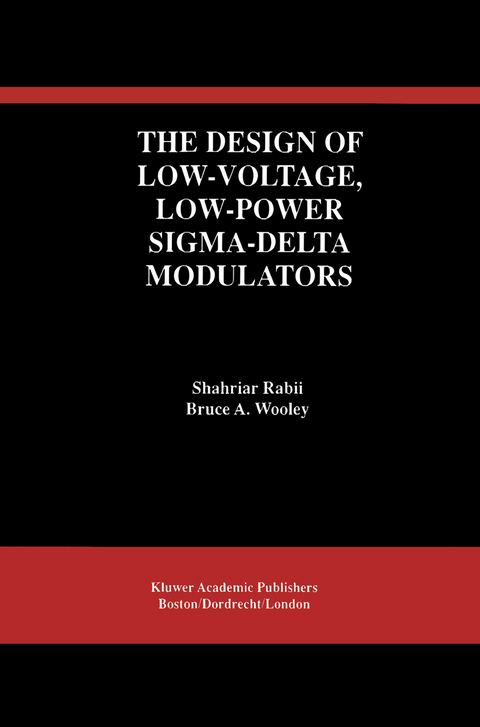
The Design of Low-Voltage, Low-Power Sigma-Delta Modulators
Springer-Verlag New York Inc.
978-1-4613-7322-3 (ISBN)
Although significant power savings can typically be achieved in digital circuits by reducing the power supply voltage, the power dissipation in analog circuits actually tends to increase with decreasing supply voltages. Oversampling architectures are a potentially power-efficient means of implementing high-resolution A/D converters because they reduce the number and complexity of the analog circuits in comparison with Nyquist-rate converters. In fact, it is shown that the power dissipation of a sigma-delta modulator can approach that of a single integrator with the resolution and bandwidth required for a given application. In this research the influence of various parameters on the power dissipation of the modulator has been evaluated and strategies for the design of a power-efficient implementation have been identified.
The Design of Low-Voltage, Low-Power Sigma-Delta Modulators begins with an overview of A/D conversion, emphasizing sigma-delta modulators. It includes a detailed analysis of noise in sigma-delta modulators, analyzes power dissipation in integrator circuits, and addresses practical issues in the circuit design and testing of a high-resolution modulator.
The Design of Low-Voltage, Low-Power Sigma-Delta Modulators will be of interest to practicing engineers and researchers in the areas of mixed-signal and analog integrated circuit design.
1 Introduction.- 1.1 Organization.- 1.2 Simulation Details.- 2 Trends Toward Low-Voltage Power Supplies.- 2.1 Technology Scaling in CMOS Processes.- 2.2 Scaling Theory.- 2.3 Battery Cell Technologies for Portable Electronic Systems.- 2.4 Summary.- 3 Analog-to-Digital Conversion.- 3.1 Analog-to-Digital Converters.- 3.2 Nyquist-Rate A/D Converters.- 3.3 Oversampling A/D Converters.- 3.4 Summary.- 4 Power Dissipation in Sigma-Delta A/D Converters.- 4.1 Power Dissipation in a Sigma-Delta Modulator.- 4.2 Ideal Integrator Power Dissipation.- 4.3 Impact of Circuit Nonidealities.- 4.4 Comparison of Amplifier Topologies.- 4.5 Power Dissipation in the Decimation Filter.- 4.6 Summary.- 5 Design of a Low-Voltage, High-Resolution Sigma-Delta Modulator.- 5.1 Modulator Architecture.- 5.2 Signal Scaling.- 5.3 Integrator Implementation.- 5.4 Circuit Noise.- 5.5 Modulator Specifications.- 5.6 Summary.- 6 Implementation of an Experimental Low-Voltage Modulator.- 6.1 The Integrators.- 6.2 The Operational Amplifiers.- 6.3 The Quantizers.- 6.4 The Clocks.- 6.5 Clock Boosters.- 6.6 Decimation Filtering.- 6.7 Experimental Results.- 6.8 Comparison of the Power Efficiency of A/D Converters.- 6.9 Summary.- 7 Conclusion.- 7.1 Recommendations for Further Investigation.- A Fundamental Limits.- A.1 Power in a Switched-Capacitor Integrator.- A.2 Power in a Continuous-Time Integrator.- A.3 Power in a Switched-Current Integrator.- B Power Dissipation vs. Supply Voltage and Oversampling Ratio.- B.1 Folded Cascode Amplifier.- B.2 Two-Stage Class A Amplifier.- B.3 Two-Stage Class A/AB Amplifier.- C Effects of Capacitor Mismatch.- D Test Setup.
| Erscheint lt. Verlag | 12.10.2012 |
|---|---|
| Reihe/Serie | The Springer International Series in Engineering and Computer Science ; 483 |
| Zusatzinfo | XVIII, 187 p. |
| Verlagsort | New York, NY |
| Sprache | englisch |
| Maße | 155 x 235 mm |
| Themenwelt | Informatik ► Weitere Themen ► CAD-Programme |
| Technik ► Elektrotechnik / Energietechnik | |
| ISBN-10 | 1-4613-7322-0 / 1461373220 |
| ISBN-13 | 978-1-4613-7322-3 / 9781461373223 |
| Zustand | Neuware |
| Haben Sie eine Frage zum Produkt? |
aus dem Bereich


